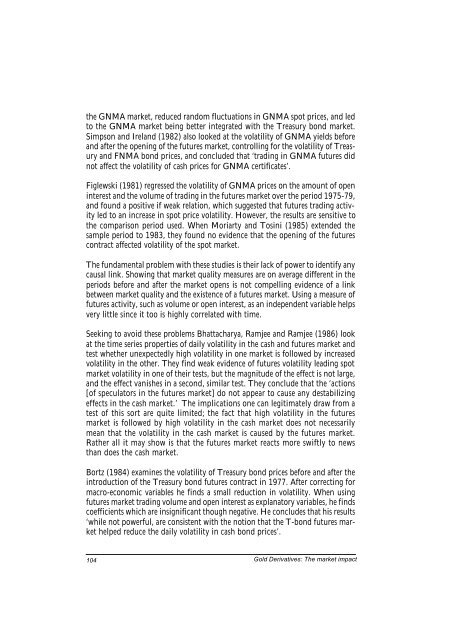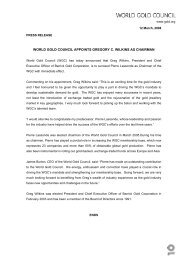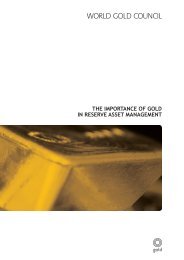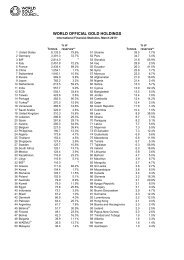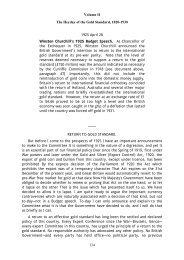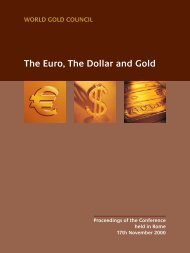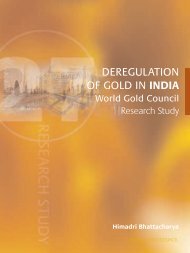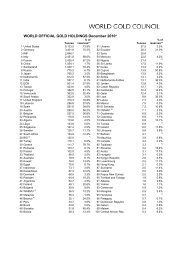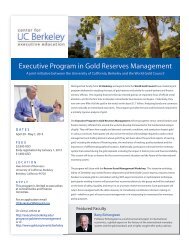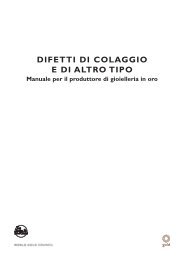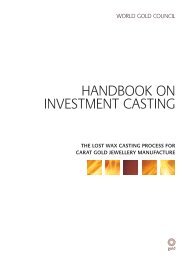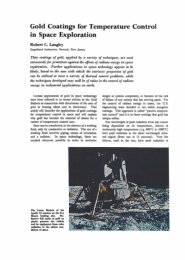Gold Derivatives: Gold Derivatives: - World Gold Council
Gold Derivatives: Gold Derivatives: - World Gold Council
Gold Derivatives: Gold Derivatives: - World Gold Council
Create successful ePaper yourself
Turn your PDF publications into a flip-book with our unique Google optimized e-Paper software.
the GNMA market, reduced random fluctuations in GNMA spot prices, and led<br />
to the GNMA market being better integrated with the Treasury bond market.<br />
Simpson and Ireland (1982) also looked at the volatility of GNMA yields before<br />
and after the opening of the futures market, controlling for the volatility of Treasury<br />
and FNMA bond prices, and concluded that ‘trading in GNMA futures did<br />
not affect the volatility of cash prices for GNMA certificates’.<br />
Figlewski (1981) regressed the volatility of GNMA prices on the amount of open<br />
interest and the volume of trading in the futures market over the period 1975-79,<br />
and found a positive if weak relation, which suggested that futures trading activity<br />
led to an increase in spot price volatility. However, the results are sensitive to<br />
the comparison period used. When Moriarty and Tosini (1985) extended the<br />
sample period to 1983, they found no evidence that the opening of the futures<br />
contract affected volatility of the spot market.<br />
The fundamental problem with these studies is their lack of power to identify any<br />
causal link. Showing that market quality measures are on average different in the<br />
periods before and after the market opens is not compelling evidence of a link<br />
between market quality and the existence of a futures market. Using a measure of<br />
futures activity, such as volume or open interest, as an independent variable helps<br />
very little since it too is highly correlated with time.<br />
Seeking to avoid these problems Bhattacharya, Ramjee and Ramjee (1986) look<br />
at the time series properties of daily volatility in the cash and futures market and<br />
test whether unexpectedly high volatility in one market is followed by increased<br />
volatility in the other. They find weak evidence of futures volatility leading spot<br />
market volatility in one of their tests, but the magnitude of the effect is not large,<br />
and the effect vanishes in a second, similar test. They conclude that the ‘actions<br />
[of speculators in the futures market] do not appear to cause any destabilizing<br />
effects in the cash market.’ The implications one can legitimately draw from a<br />
test of this sort are quite limited; the fact that high volatility in the futures<br />
market is followed by high volatility in the cash market does not necessarily<br />
mean that the volatility in the cash market is caused by the futures market.<br />
Rather all it may show is that the futures market reacts more swiftly to news<br />
than does the cash market.<br />
Bortz (1984) examines the volatility of Treasury bond prices before and after the<br />
introduction of the Treasury bond futures contract in 1977. After correcting for<br />
macro-economic variables he finds a small reduction in volatility. When using<br />
futures market trading volume and open interest as explanatory variables, he finds<br />
coefficients which are insignificant though negative. He concludes that his results<br />
‘while not powerful, are consistent with the notion that the T-bond futures market<br />
helped reduce the daily volatility in cash bond prices’.<br />
104<br />
<strong>Gold</strong> <strong>Derivatives</strong>: The market impact


